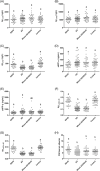Blood-brain barrier dysfunction and reduced cerebrospinal fluid levels of soluble amyloid precursor protein-β in patients with subcortical small-vessel disease
- PMID: 35356486
- PMCID: PMC8949877
- DOI: 10.1002/dad2.12296
Blood-brain barrier dysfunction and reduced cerebrospinal fluid levels of soluble amyloid precursor protein-β in patients with subcortical small-vessel disease
Abstract
Introduction: Subcortical small-vessel disease (SSVD) is the most common vascular cognitive disorder. However, because no disease-specific cerebrospinal fluid (CSF) biomarkers are available for SSVD, our aim was to identify such markers.
Methods: We included 170 healthy controls and patients from the Gothenburg Mild Cognitive Impairment (MCI) study clinically diagnosed with SSVD dementia, Alzheimer's disease (AD), or mixed AD/SSVD. We quantified CSF levels of amyloid-β (Aβ)x-38, Aβx-40, Aβx-42, as well as soluble amyloid precursor protein (sAPP)-α and sAPP-β.
Results: sAPP-β was lower in SSVD patients than in AD patients and controls. Receiver-operating characteristic (ROC) analyses showed that sAPP-β moderately separated SSVD from AD and controls. Moreover, the CSF/serum albumin ratio was elevated exclusively in SSVD and could moderately separate SSVD from the other groups in ROC analyses.
Discussion: SSVD has a biomarker profile that differs from that of AD and controls, and to some extent also from mixed AD/SSVD, suggesting that signs of blood-brain barrier (BBB) dysfunction and sAPP-β could be additional tools to diagnose SSVD.
Highlights: Patients with subcortical small-vessel disease (SSVD) exhibited reduced levels of sAPP-β and disturbances of the blood-brain barrier (BBB).This biochemical pattern is different from that of Alzheimer's disease (AD) and to some degree from that of mixed AD/SSVD.Our findings are speaking in favor of the concept that SSVD is a distinct vascular cognitive disorder (VCD) form.
Keywords: Alzheimer's disease; amyloid beta; blood‐brain barrier; cerebrospinal fluid; subcortical small‐vessel disease.
© 2022 The Authors. Alzheimer's & Dementia: Diagnosis, Assessment & Disease Monitoring published by Wiley Periodicals, LLC on behalf of Alzheimer's Association.
Conflict of interest statement
Petronella Kettunen, Maria Bjerke, Carl Eckerström, and Johan Svensson: no conflicts of interest. Michael Jonsson: Consulting fees for assignment as paid advisory board member for Biogen 2020‐2021. Henrik Zetterberg has served at scientific advisory boards and/or as a consultant for Abbvie, Alector, Eisai, Denali, Roche, Wave, Samumed, Siemens Healthineers, Pinteon Therapeutics, Nervgen, AZTherapies, CogRx, and Red Abbey Labs; has given lectures in symposia sponsored by Cellectricon, Fujirebio, Alzecure, and Biogen; and is a co‐founder of Brain Biomarker Solutions in Gothenburg AB (BBS), which is a part of the GU Ventures Incubator Program (outside submitted work). Kaj Blennow has served as a consultant, on advisory boards, or on data‐monitoring committees for Abcam, Axon, Biogen, JOMDD/Shimadzu. Julius Clinical, Lilly, MagQu, Novartis, Prothena, Roche Diagnostics, and Siemens Healthineers; and is a co‐founder of Brain Biomarker Solutions in Gothenburg AB (BBS), which is a part of the GU Ventures Incubator Program, all unrelated to the work presented in this article. Anders Wallin: Lecture fees from Lundbeck.
Figures

Similar articles
-
Diagnostic Performance of Cerebrospinal Fluid Neurofilament Light Chain and Soluble Amyloid-β Protein Precursor β in the Subcortical Small Vessel Type of Dementia.J Alzheimers Dis. 2023;96(4):1515-1528. doi: 10.3233/JAD-230680. J Alzheimers Dis. 2023. PMID: 37980667 Free PMC article.
-
Biochemical markers in vascular cognitive impairment associated with subcortical small vessel disease - A consensus report.BMC Neurol. 2017 May 23;17(1):102. doi: 10.1186/s12883-017-0877-3. BMC Neurol. 2017. PMID: 28535786 Free PMC article. Review.
-
Exploratory Analysis of Cerebrospinal Fluid IL-6 and IL-17A Levels in Subcortical Small-Vessel Disease Compared to Alzheimer's Disease: A Pilot Study.Diagnostics (Basel). 2025 Mar 10;15(6):669. doi: 10.3390/diagnostics15060669. Diagnostics (Basel). 2025. PMID: 40150012 Free PMC article.
-
Effects of cerebrovascular disease on amyloid precursor protein metabolites in cerebrospinal fluid.Cerebrospinal Fluid Res. 2010 Jul 30;7:10. doi: 10.1186/1743-8454-7-10. Cerebrospinal Fluid Res. 2010. PMID: 20673341 Free PMC article.
-
Update on Vascular Cognitive Impairment Associated with Subcortical Small-Vessel Disease.J Alzheimers Dis. 2018;62(3):1417-1441. doi: 10.3233/JAD-170803. J Alzheimers Dis. 2018. PMID: 29562536 Free PMC article. Review.
Cited by
-
Elevated Plasma Oligomeric Amyloid β-42 Is Associated with Cognitive Impairments in Cerebral Small Vessel Disease.Biosensors (Basel). 2023 Jan 7;13(1):110. doi: 10.3390/bios13010110. Biosensors (Basel). 2023. PMID: 36671945 Free PMC article.
-
Which neuroimaging and fluid biomarkers method is better in theranostic of Alzheimer's disease? An umbrella review.IBRO Neurosci Rep. 2024 Feb 29;16:403-417. doi: 10.1016/j.ibneur.2024.02.007. eCollection 2024 Jun. IBRO Neurosci Rep. 2024. PMID: 38497046 Free PMC article. Review.
-
Molecular biomarkers for vascular cognitive impairment and dementia: the current status and directions for the future.Neural Regen Res. 2024 Dec 1;19(12):2579-2580. doi: 10.4103/NRR.NRR-D-23-01938. Epub 2024 Mar 1. Neural Regen Res. 2024. PMID: 38808990 Free PMC article. No abstract available.
-
Risk of cognitive decline progression is associated to increased blood-brain-barrier permeability: A longitudinal study in a memory unit clinical cohort.Alzheimers Dement. 2024 Jan;20(1):538-548. doi: 10.1002/alz.13433. Epub 2023 Sep 19. Alzheimers Dement. 2024. PMID: 37727082 Free PMC article.
-
Diagnostic Performance of Cerebrospinal Fluid Neurofilament Light Chain and Soluble Amyloid-β Protein Precursor β in the Subcortical Small Vessel Type of Dementia.J Alzheimers Dis. 2023;96(4):1515-1528. doi: 10.3233/JAD-230680. J Alzheimers Dis. 2023. PMID: 37980667 Free PMC article.
References
-
- Chui H. Dementia due to subcortical ischemic vascular disease. Clin Cornerstone. 2001;3:40‐51. - PubMed
-
- Wardlaw JM, Makin SJ, Valdés Hernández MC, et al. Blood‐brain barrier failure as a core mechanism in cerebral small vessel disease and dementia: evidence from a cohort study. Alzheimer's Dement. 2017;13:634.
Grants and funding
LinkOut - more resources
Full Text Sources
